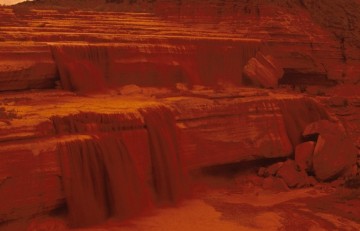Grand Canyon Hikes

- Hiking VacationZion National Park is home to some of the most incredible hiking trails in the world with hiking tours for everyone. Zion National Park has a wide diversity of trails, for both beginners and advanced hikers. Choose from short nature walks, to canyon overlook trails that lead to high plateaus over two thousand feet above the Virgin River in the bottom of the path. Adventure seekers will get the thrill of a lifetime as they journey through the world famous Zion Narrows, a collection of slot canyons that converge to form Zion Canyon.
- Zion Rock & Mountain GuidesOffering "the most comprehensive guide service in Southern Utah," Zion Rock & Mountain Guides provides great guided tours and other resources created and run by experienced outdoor professionals who are passionate about Zion National Park.
Hiking Trails
South Rim
Hiking the Grand Canyon’s South Rim is an incredible adventure. There are Day Hikes available at the South Rim for people of all levels of hiking ability. Visitors to the Grand Canyon should remember that this is a desert area and plan to bring plenty of water or re-hydrating sports drink when hiking any of the trails located at the South Rim.
Day Hikes
Rim Trail Hike
The Rim Trail begins at Pipe Creek and ends at Hermits Rest. The trail is approximately 12-miles one-way. From Pipe Creek to Maricopa Point (1.9-miles) is paved and wheelchair accessible, both overlook areas offer amazing views of the canyon. From Maricopa to Hermits Rest several sections of the trail are unpaved and come very close to the edge. There are 13 overlook points along the Rim Trail, 10 of which are also shuttle stops.
Bikes are NOT allowed on this trail.
Bright Angel Trail
The Bright Angel Trail is one of several leading into the Grand Canyon; visitors need to be aware that there are no easy trails into the canyon. However, there are turn around points along the trail to accommodate different hiking levels. Bright Angle has eight viewpoints along the trail which can be used to gauge the miles traveled, but keep in mind that the trail is steep and going back will be more difficult. The following are some of the primary viewpoints found along the Bright Angle Trail.
- 1st Tunnel. This section of the trail is not too steep and is good for people looking for a walk that is not too strenuous. It is about 0.36 mile to the 1st Tunnel and back.
- 1st Switchback. This is a good location for people hiking with small children to turn back. After this point the switchbacks start getting steep. It is about a 0.9 mile round trip to the 1st Switchback.
- 2nd Tunnel. This is about a 1.5 mile hike and past this point the trail becomes very steep on the other side of the tunnel. This is where non-experienced hikers should turn back.
- The 1.5 Mile Resthouse. This is the first stop on the trail that offers water, restrooms and emergency phone. The 3-mile round-trip is good for casual hikers to start back.
- Indian Garden. During the summer season, hikers are encouraged not to go any further than this viewpoint. It is a 9.2 mile round-trip to Indian Garden and in the heat of the day this hike can be quite challenging for any hiker. There is also water, restrooms and emergency phone available at this section of the trail.
South Kaibab Trail
The South Kaibab Trail offers hikes for causal and experienced hikers only. Beginners should stick to the Bright Angle Trail. There is no water along this trail so hikers should plan ahead and bring enough water for return trip. The South Kaibab Trail has six viewpoints offering tremendous views of the canyon, three of which are considered to be Day Hikes. Keep in mind that the trail is steep and it will be more difficult to climb out of the canyon. Turn back before you run out of energy.
- Ooh-Aah Point. There is no sign marking this view area, the trail begins to widen at Ooh-Aah Point. It is a 1.5 mile round trip to this part of the trail.
- Cedar Ridge. Located 1.5 miles into the Grand Canyon. This is a good place for causal hikers or those getting a late start to turn around. The National Park Service recommends no-one hike past this point as part of a Day Hike during the summer season. There is no sign marking the Cedar Ridge view area, hikers will know they have reached this location when they find the first hitching post along the trail.
- Skeleton Point. This is the furthest viewpoint on the South Kaibab Trail that can still be classified as a Day Hike. It is a six-mile round trip to this section of the trail. There is a trail sign marking the viewpoint. The switchbacks get much steeper after this point
Hermit Trail

- Santa Maria Springs view area is located on the right hand trail and is about 4.5 miles round trip. At the view area hikers will find a small shelter and water. The water must be treated before drinking.
- Boucher Trail Junction can be reached by taking the left hand trail at Hermit Junction. It is a 5.5 mile round trip. There is no water available at this location.
- Dipping Spring is about a mile further than Boucher Trail Junction. There is water available at Dipping Spring. However, the water must be treated before drinking. The National Park Service also recommends that hikers be extra cautious on this section of the trail due to the trail narrowing and coming extremely close to the edge.
Grand View Trail
This trail leads to Horseshoe Mesa and there are three viewpoints along the way. However, the 1.5 mile round trip to Coconino Saddle is the only spot recommended as a day hike due to trail conditions. There are camping facilities at Horseshoe Mesa for those wanting to continue to that point. There is no water along this trail so hikes should plan ahead and bring enough water for return trip.
North Rim
Hiking the Grand Canyon’s North Rim is a lesson in diversity. The trails offer something for hikers of all abilities that offer magnificent views of the canyon at every turn. Being at a higher elevation than the South Rim, the North Rim will bring a different perspective and cooler temperatures to this grandest of canyons. However, don’t do be deceived by the cooler temperatures and forested areas this is still a desert region and hikers will need to bring plenty of water on their adventures.
Day Hikes
Bright Angel Point Trail
This trail begins at the North Rim parking lot and continues ½ mile down the paved, marked trail. Once reaching the overlook area visitors will be treated to an amazing view of the Grand Canyon. The total walking time for this trail is approximately 30 minutes.
Transept Trail
The Transept Trail begins just below the patio of the North Rim Lodge and continues to a campground located about 1.5 miles from the lodge. This scenic path rewards day hikers with a restroom and toilet once they have reached their destination. A short walk further will lead hikers to an overlook point.
Uncle Jim Trail
The trailhead is located at North Kaibab Trail parking lot and meanders through the forest to a canyon overlook. The mix of forest and desert on this trail makes this a must do for all hikers visiting the North Rim of the Grand Canyon. This is a 5 mile round trip hike and will take approximately 3 hours to complete.
North Kaibab Trail
The North Kaibab Trail is the only trail leading to the bottom of the canyon from the North Rim. Although the hike to the bottom of the Grand Canyon is only for the most experienced hikers, there are several locations along the trail that day hikers can use as turn-back points.
Widforss Point
Widforss Point is a rim hike with 2.1 miles of the trail being marked with self-guided tour information. The overlook is another 4.9 miles past the last informational sign. There trial is paved and maintained but does have some steep inclines along the way. The trail is partly shaded, but hikers should bring water and snack food along due to the distance of the trail.
- Supai Tunnel is 1.8 miles into the North Kaibab Trail. The National Parks Service recommends this turn around for first time hikers into the Grand Canyon or if hikers are getting a late start. Water and restrooms are available at this location.
- Redwall Bridge is a good hike for day hikers with more canyon hiking experience. The bridge is 3 miles into the trail. Although this is a picturesque hike most of the trail is not shaded from late morning through the afternoon. Brining extra water on this hike is recommended.
- Roaring Springs is the furthest point that day hikes should go on the North Kaibab Trail. It is a 10 mile round trip, with a rather steep climb back to the rim. Water and restrooms are available at this location, but water accessibility at this location can be seasonal. Be sure to bring enough water to make the return trip.
Rim to Rim Hike
The National Park Service does not recommend making the hike from rim to rim in one day. The hike does require a permit and reservations at one of the three campgrounds or Phantom Ranch which is a dormitory type facility near the Colorado River at the base of the Grand Canyon. Hikes should be scheduled with park services at least four months in advance.
Plan to carry enough water to make it to the bottom and refill at the campgrounds or ranch. Bring high energy snacks and foods. Eat often, drink often and rest several times a day while doing the rim to rim hike at the Grand Canyon.
Most rim to rim hikers like to begin their adventure on the South Rim taking either the South Kaibab Trail or the Bright Angle Trail into the canyon. The South Rim is preferred to start the hike due the lack of shade and because it is an awesome experience to begin the adventure with the Grand Canyon in front of you. The North Rim the trailhead is forested allowing only small glimpses of the canyon while descending.
When climbing to the North Rim, hikers should plan on their day being 14 or more hours. There are many side trails leading to water falls and other interesting sites along the trail out.
Hikers should plan on a minimum of two days on the trail. For a more leisurely, sight filled trip plan to stay two nights and three days in the canyon, camping one night at the bottom of the canyon and one night at the campground located on the North Kaibab Trail.
Did you like this page? Did you find it helpful? Please consider sharing.
